Thin Films Deposition of Ta2O5 and ZnO by E-Gun Technology on Co-Cr Alloy Manufactured by Direct Metal Laser Sintering
Abstract
1. Introduction
2. Materials and Methods
2.1. Co-Cr Samples Made by DMLS Process and Coated with Ta2O5 by E-Gun Technology
2.2. SEM and EDS Analyses of Co-Cr Samples Fabricated by the DMLS Process and Coated with Ta2O5 by E-Gun Technology
2.3. XRD Analysis
2.4. AFM Analysis of the Surface Morphology and Roughness
2.5. Hardness and Modulus of Elasticity Determination Using Nanoindentation Method
3. Results and Discussions
3.1. Co-Cr Samples Fabricated by the DMLS Process and Coated with Ta2O5 by E-Gun Technology
3.2. SEM and EDS Analyses of Co-Cr Samples Fabricated by the DMLS Process and Coated with Ta2O5 by E-Gun Technology
3.3. XRD Analysis of Sintered Samples of Co-Cr Alloy by the DMLS Process and Coated with Thin Films by E-Gun Technology
3.4. AFM Analyses of the Surface Morphology and Roughness
3.5. Hardness and Modulus of Elasticity Determined Using the Nanoindentation Method
4. Conclusions
Author Contributions
Funding
Institutional Review Board Statement
Informed Consent Statement
Data Availability Statement
Conflicts of Interest
References
- Dobrzański, L.A.; Dobrzański, L.B. Dentistry 4.0 concept in the design and manufacturing of prosthetic dental restorations. Processes 2020, 8, 525. [Google Scholar] [CrossRef]
- Okazaki, Y.; Ishino, A.; Higuchi, S. Chemical, physical, and mechanical properties and microstructures of laser-sintered Co-25Cr-5Mo-5W (SP2) and W-Free Co-28Cr-6Mo alloys for dental applications. Materials 2019, 12, 4039. [Google Scholar] [CrossRef] [PubMed]
- Dikova, T. Properties of Co-Cr Dental Alloys Fabricated Using Additive Technologies. In Biomaterials in Regenerative Medicine; IntechOpen: London, UK, 2018; pp. 141–159. [Google Scholar]
- Oliveira, T.T.; Reis, A.C. Fabrication of dental implants by the additive manufacturing method: A systematic review. J. Prosthet. Dent. 2019, 122, 270–274. [Google Scholar] [CrossRef] [PubMed]
- Girardin, E.; Barucca, G.; Mengucci, P.; Fiori, F.; Bassoli, E.; Gatto, A.; Iuliano, L.; Rutkowski, B. Biomedical Co-Cr-Mo components produced by Direct Metal Laser Sintering. Mater. Today-Proc. 2016, 3, 889–897. [Google Scholar] [CrossRef]
- Konieczny, B.; Szczesio-Wlodarczyk, A.; Sokolowski, J.; Bociong, K. Challenges of Co-Cr alloy additive manufacturing methods in dentistry—The current state of knowledge (Systematic Review). Materials 2020, 13, 3524. [Google Scholar] [CrossRef]
- Ngo, T.D.; Kashani, A.; Imbalzano, G.; Nguyen, K.T.Q.; Hui, D. Additive manufacturing (3D printing): A review of materials, methods, applications and challenges. Compos. Part B Eng. 2018, 143, 172–196. [Google Scholar] [CrossRef]
- Chhaya, M.P.; Poh, P.S.P.; Balmayor, E.R.; Van Griensven, M.; Schantz, J.T.; Hutmacher, D.W. Additive manufacturing in biomedical sciences and the need for definitions and norms. Expert Rev. Med. Devices 2015, 12, 537. [Google Scholar] [CrossRef]
- Revilla-León, M.; Özcan, M. Additive Manufacturing Technologies Used for 3D Metal Printing in Dentistry. Curr. Oral Health Rep. 2017, 4, 201–208. [Google Scholar] [CrossRef]
- Han, X.; Sawada, T.; Schille, C.; Schweizer, E.; Scheideler, L.; Geis-Gerstorfer, J.; Rupp, F.; Spintzyk, S. Comparative analysis of mechanical properties and metal-ceramic bond strength of Co-Cr dental alloy fabricated by different manufacturing processes. Materials 2018, 11, 1801. [Google Scholar] [CrossRef] [PubMed]
- Sahasrabudhe, H.; Bose, S.; Bandyopadhyay, A. Laser-Based Additive Manufacturing Processes. In Advances in Laser Materials Processing; Lawrence, J., Ed.; Woodhead Publishing: Coventry, UK, 2018; pp. 507–539. [Google Scholar]
- Song, C.; Yang, Y.; Wang, Y.; Wang, D.; Yu, J. Research on rapid manufacturing of Co-Cr-Mo alloy femoral component based on selective laser melting. Int. J. Adv. Manuf. Technol. 2014, 75, 445–453. [Google Scholar] [CrossRef]
- Lu, Y.; Wu, S.; Gan, Y.; Li, J.; Zhao, C.; Zhuo, D.; Lin, J. Investigation on the microstructure, mechanical property and corrosion behavior of the selective laser melted Co-Cr-W alloy for dental application. Mater. Sci. Eng. C 2015, 49, 517–525. [Google Scholar] [CrossRef] [PubMed]
- Myszka, D.; Skrodzki, M. Comparison of Dental Prostheses Cast and Sintered by SLM from Co-Cr-Mo-W Alloy. Arch. Foundry Eng. 2016, 16, 201–207. [Google Scholar] [CrossRef][Green Version]
- Antanasova, M.; Kocjan, A.; Kovač, J.; Žužek, B.; Jevnikar, P. Influence of thermo-mechanical cycling on porcelain bonding to cobalt–chromium and titanium dental alloys fabricated by casting, milling, and selective laser melting. J. Prosthodont. Res. 2018, 62, 184–194. [Google Scholar] [CrossRef]
- Ferraiuoli, P.; Taylor, J.C.; Martin, E.; Fenner, J.W.; Narracott, A.J. The accuracy of 3D optical reconstruction and additive manufacturing processes in reproducing detailed subject-specific anatomy. J. Imaging 2017, 3, 45. [Google Scholar] [CrossRef]
- Sedlak, J.; Ptackova, M.; Nejedly, J.; Madaj, M.; Dvoracek, J.; Zouhar, J.; Charvat, O.; Piska, M.; Rozkosny, L. Material analysis of titanium alloy produced by Direct Metal Laser Sintering. Int. J. Met. 2013, 7, 43–50. [Google Scholar] [CrossRef]
- Reclaru, L.; Ardelean, L.C. Current Alternatives for Processing CoCr Dental Alloys Lucien; Elsevier Inc.: Cambridge, MA, USA, 2018; Volume 1–3, ISBN 9780128051443. [Google Scholar]
- Hunt, J.A.; Callaghan, J.T.; Sutcliffe, C.J.; Morgan, R.H.; Halford, B.; Black, R.A. The design and production of Co-Cr alloy implants with controlled surface topography by CAD-CAM method and their effects on osseointegration. Biomaterials 2005, 26, 5890–5897. [Google Scholar] [CrossRef] [PubMed]
- Hacini, N.; Ghamnia, M.; Dahamni, M.A.; Boukhachem, A.; Pireaux, J.J.; Houssiau, L. Compositional, structural, morphological, and optical properties of ZnO thin films prepared by PECVD technique. Coatings 2021, 11, 202. [Google Scholar] [CrossRef]
- Chang, Y.Y.; Lai, C.H.; Hsu, J.T.; Huang, H.L. Antibacterial properties and human gingival fibroblast cell compatibility of TiO2/Ag compound coatings and ZnO films on titanium-based material. Clin. Oral Investig. 2011, 16, 95–100. [Google Scholar] [CrossRef] [PubMed]
- Horandghadim, N.; Allafi, J.K.; Urgen, M. Effect of Ta2O5 content on the osseointegration and cytotoxicity behaviours in hydroxyapatite–Ta2O5 coatings applied by EPD on superelastic NiTi alloys. Mater. Sci. Eng. C 2019, 102, 683–695. [Google Scholar] [CrossRef]
- Luang, H.L.; Chang, Y.Y.; Chen, H.J.; Chou, Y.K.; Lai, C.H.; Chen, M.Y.C. Antibacterial properties and cytocomatibility of tantalum oxide coatings. Surf. Coat. Tech. 2014, 259, 193–198. [Google Scholar]
- Pham, V.H.; Lee, S.H.; Li, Y.; Koh, Y.H. Utility of tantalum (Ta) coating to improve surface hardness in vitro bioactivity and biocompatibility of Co-Cr. Thin Solid Film. 2013, 536, 269–274. [Google Scholar] [CrossRef]
- Sui, S.Y.; Chang, J.H.; Huang, H.H. Corrosion resistance and biocompatibility of titanium surface coated with amorphous tantalum pentoxide. Thin Solid Film. 2013, 528, 130–135. [Google Scholar]
- Perez, I.; Sosa, V.; Perera, F.G.; Galindo, J.T.E.; Enriquez-Carrejo, J.L.; Gonzales, P.G.M. Effect of ion bombardment on the chemical properties of crystalline tantalum pentoxide films. Vacuum 2019, 165, 274. [Google Scholar] [CrossRef]
- Koc, K.; Tepehan, F.Z.; Tepehan, G.G. Antireflecting coating from Ta2O5 and SiO2 multilayer films. J. Mater. Sci. 2005, 40, 1363–1366. [Google Scholar] [CrossRef]
- Hardness of Coatings on Medical Implants. Available online: https://www.helmut-fischer.com/hardness-of-coatings-on-medical-implants (accessed on 25 May 2021).
- Geraldo, M. Surface Roughness of Dental Implant and Osseointegration. J. Maxillofac. Oral Surg. 2020, 20. [Google Scholar] [CrossRef]
- Characteristics and Performances of the Phenix Systems PHX Pro200 Dental Equipment Item. Available online: http://www.stroumbos.com/index.php/en/products-eng/machines-en/sintering-en/187-phenix-systems-pxs200-en.html (accessed on 2 June 2021).
- The Engineering Properties of Co-Cr Alloys (ST2724G) Provided by Phenix Systems. Available online: http://brochure.copiercatalog.com/3d-systems/brochure_dentaire_gb.pdf (accessed on 8 June 2021).
- Oliver, W.C.; Pharr, G.M. An improved technique for determining hardness and elastic-modulus using load and displacement sensing indentation experiments. J. Mater. Res. 1992, 7, 1564–1583. [Google Scholar] [CrossRef]
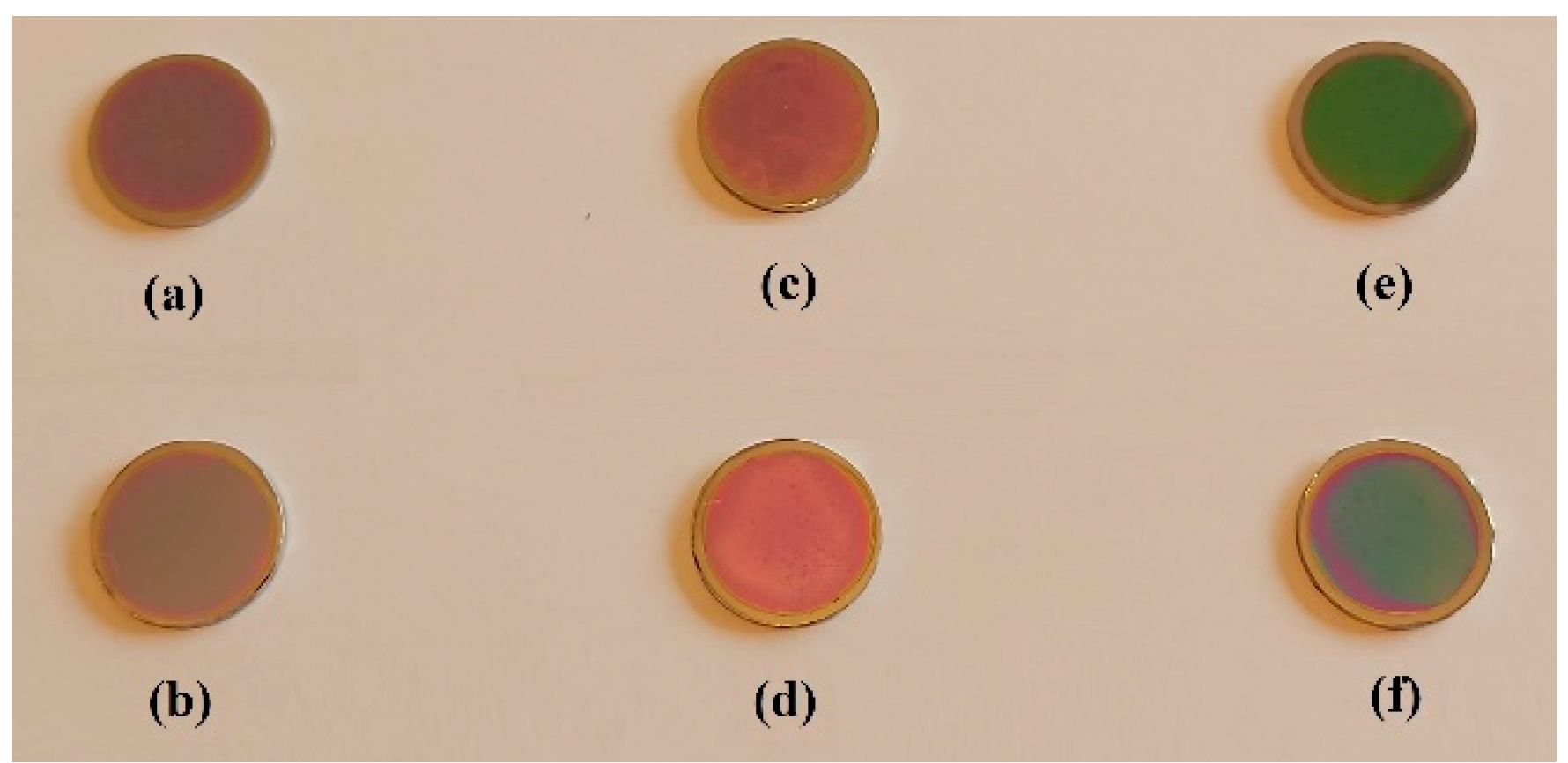
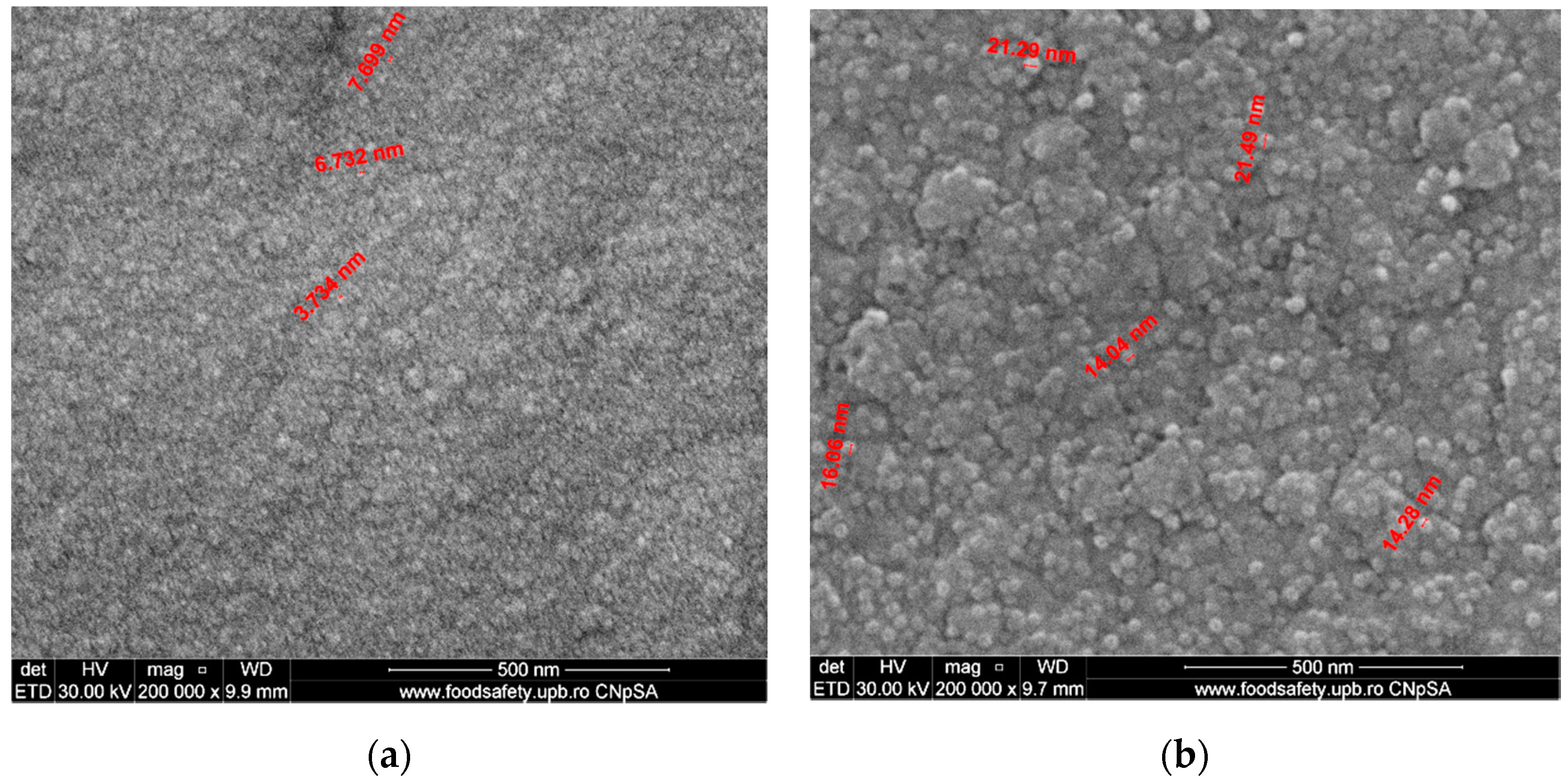
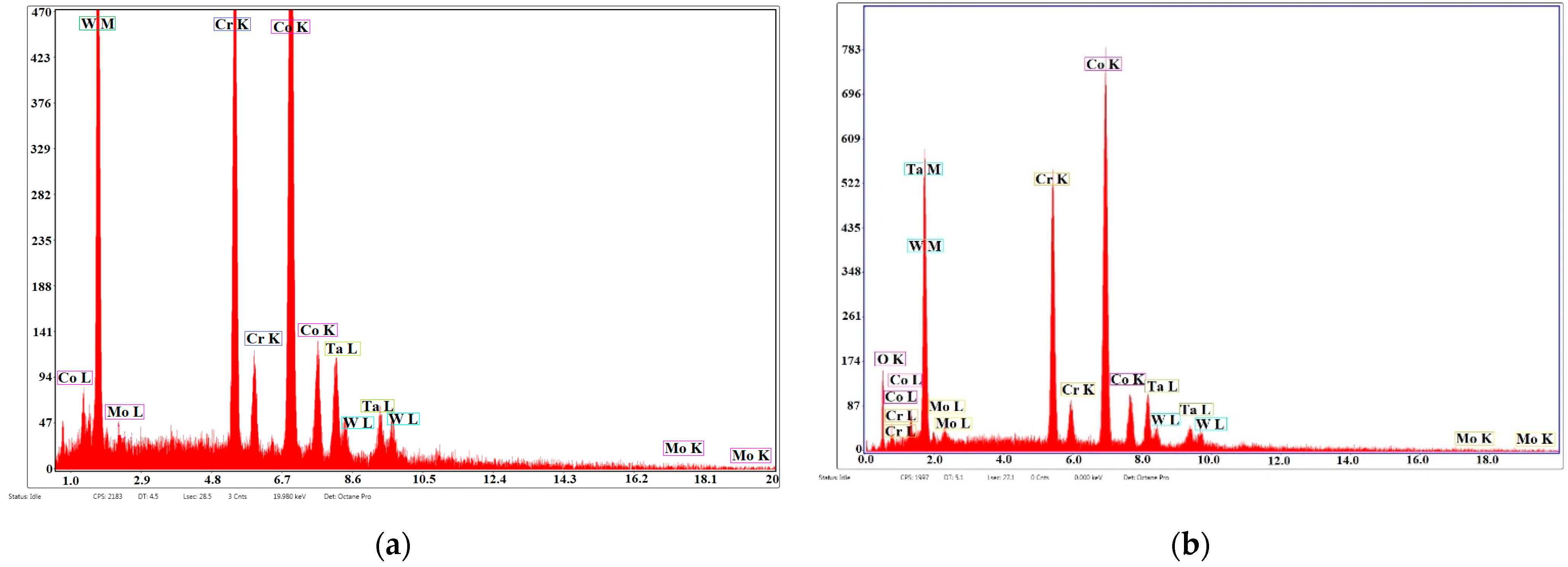

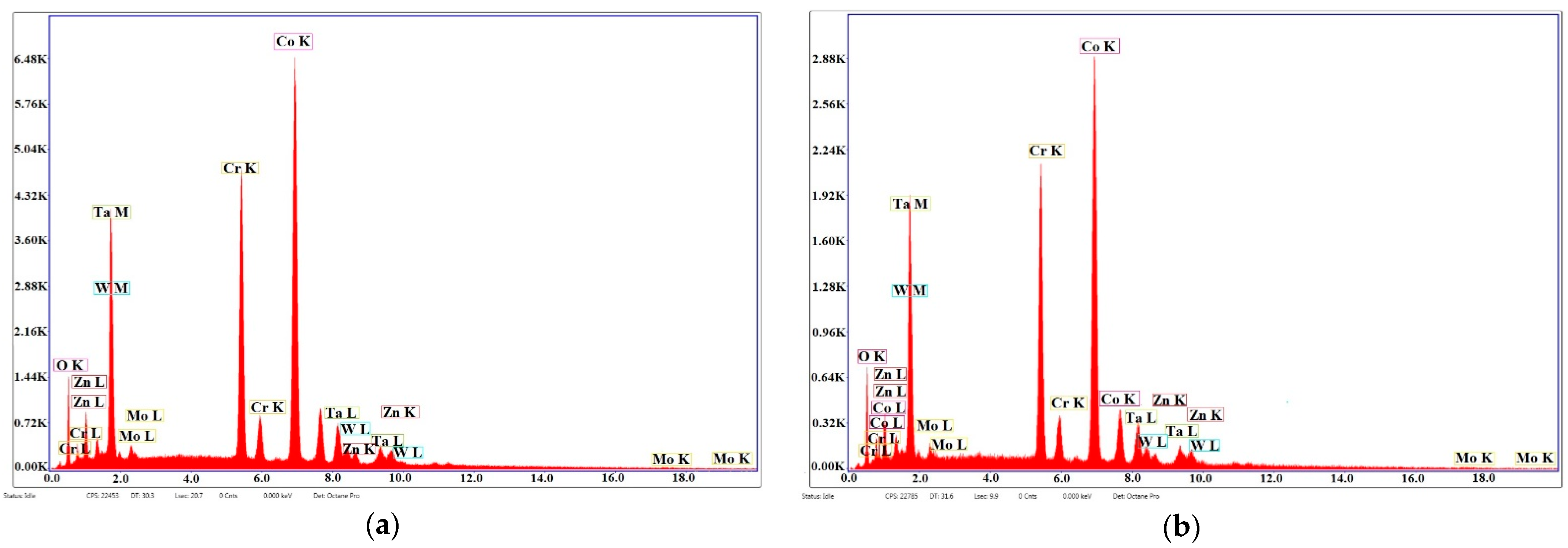
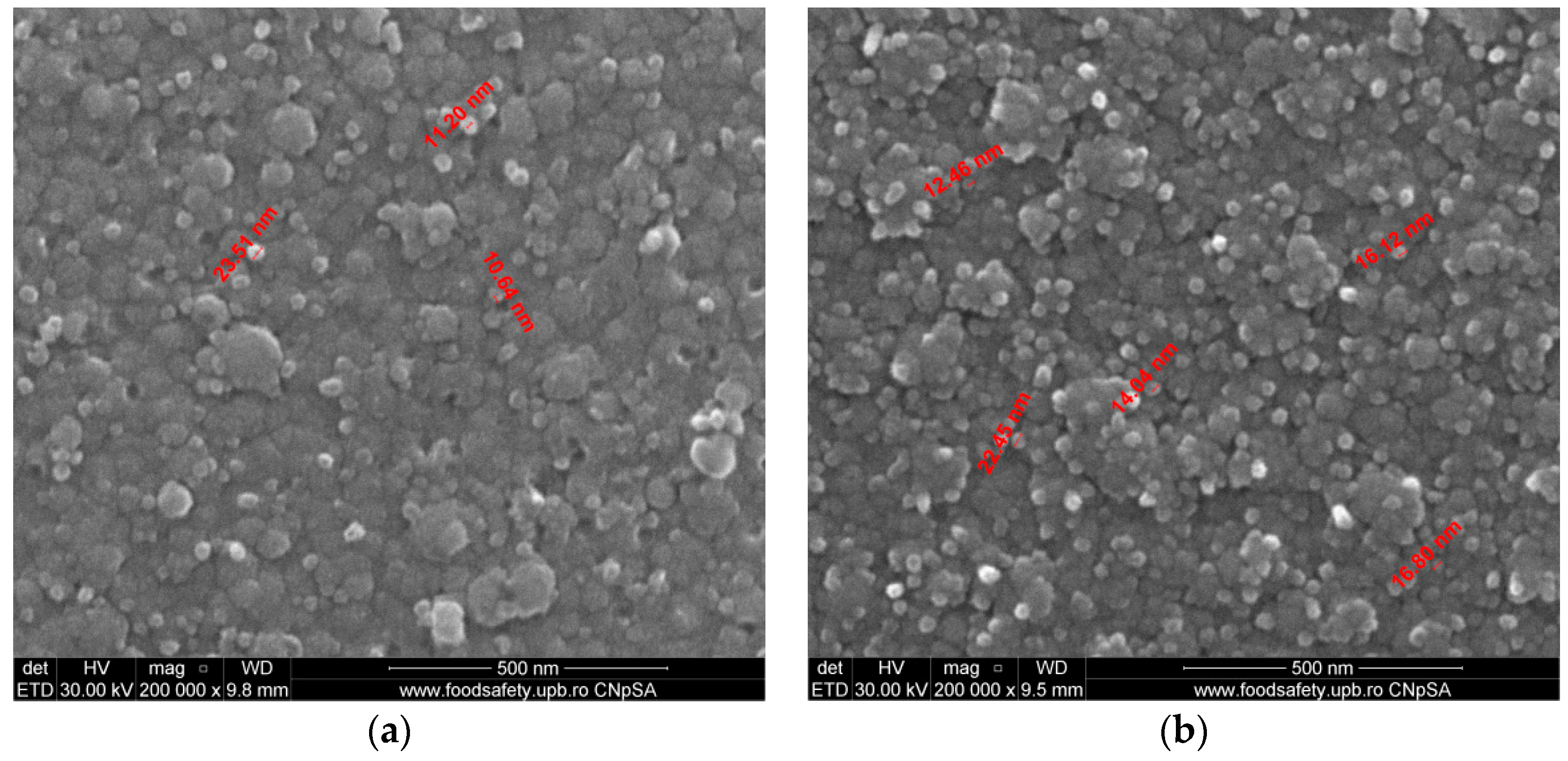

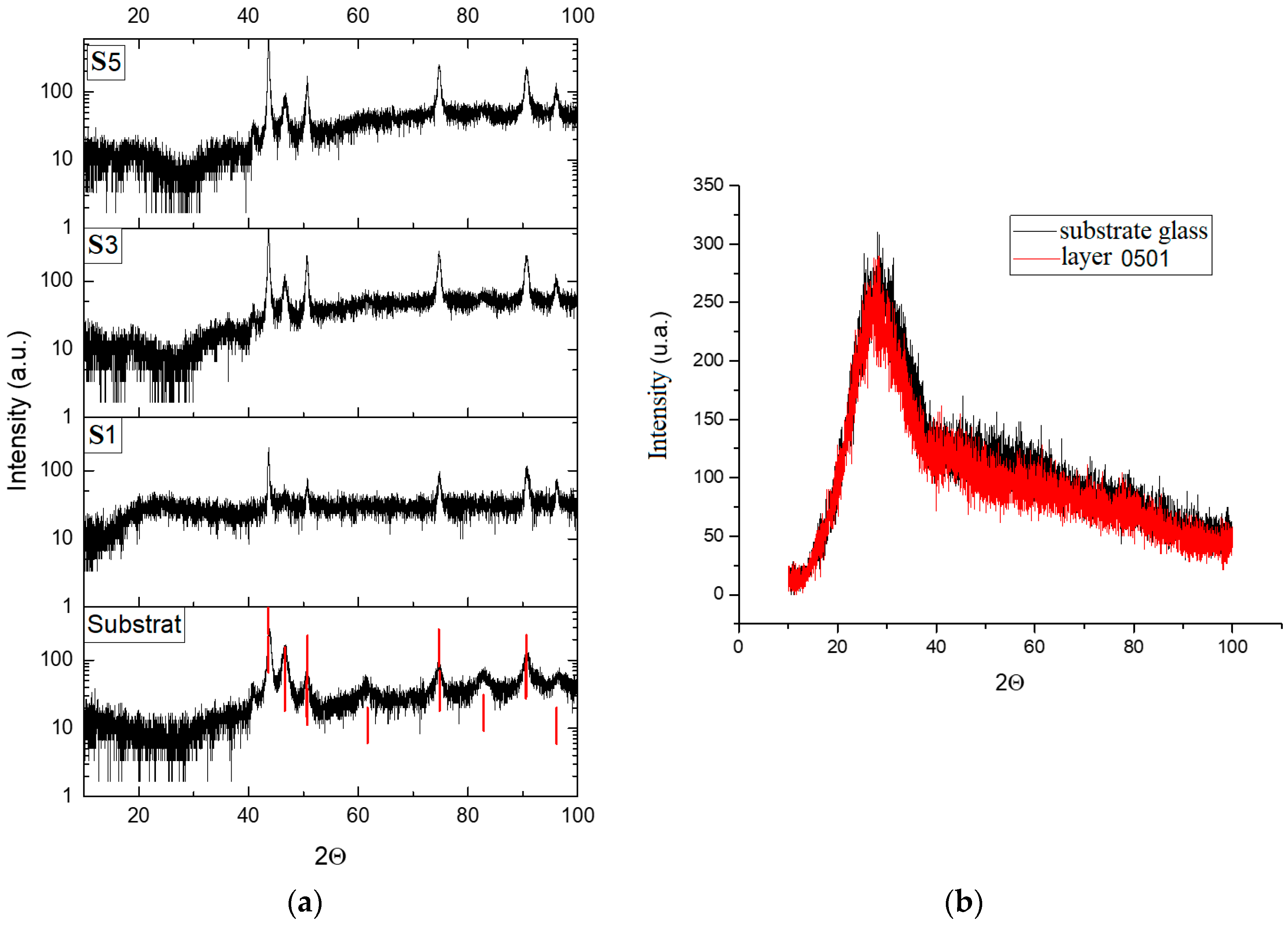
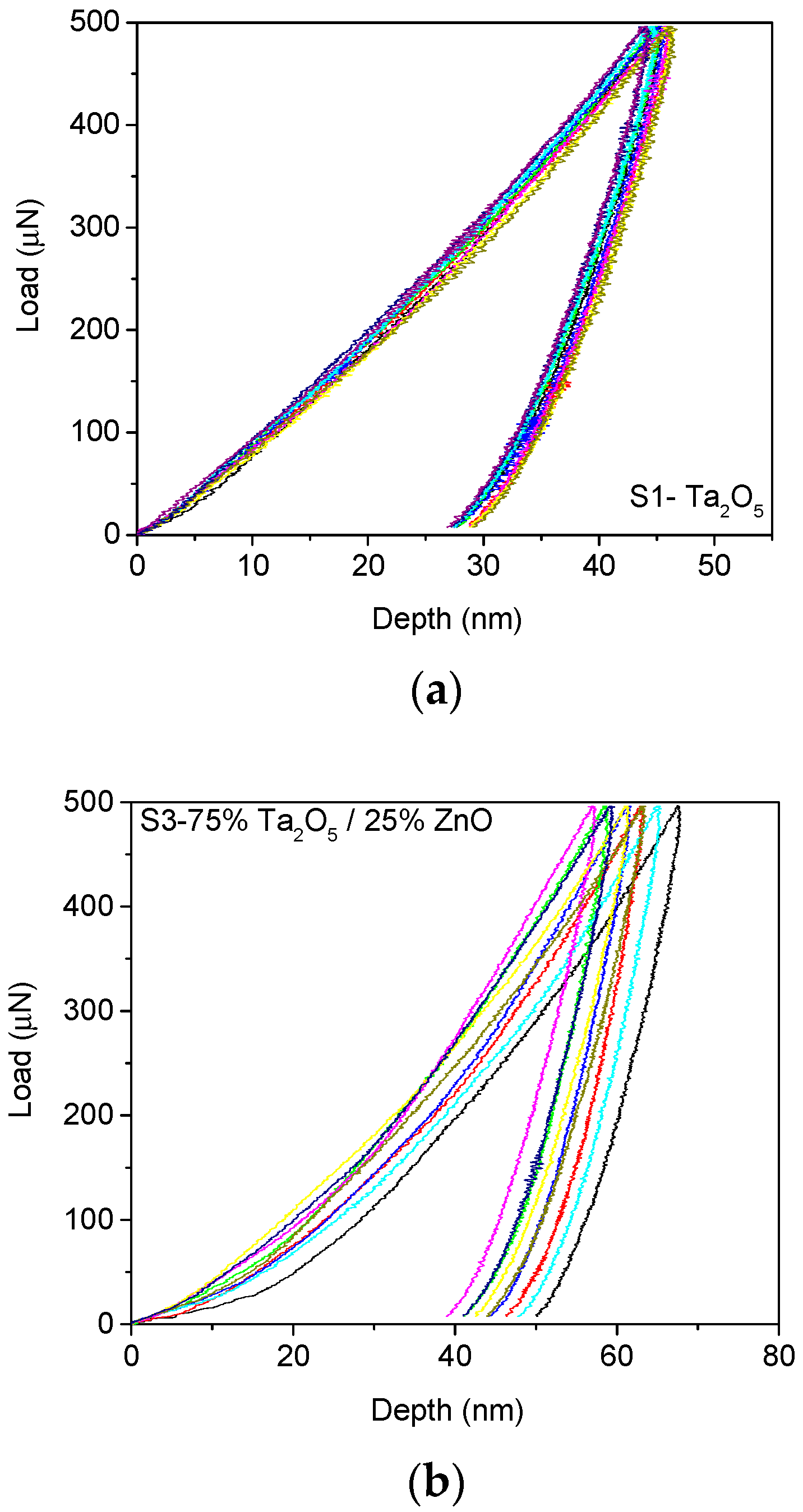
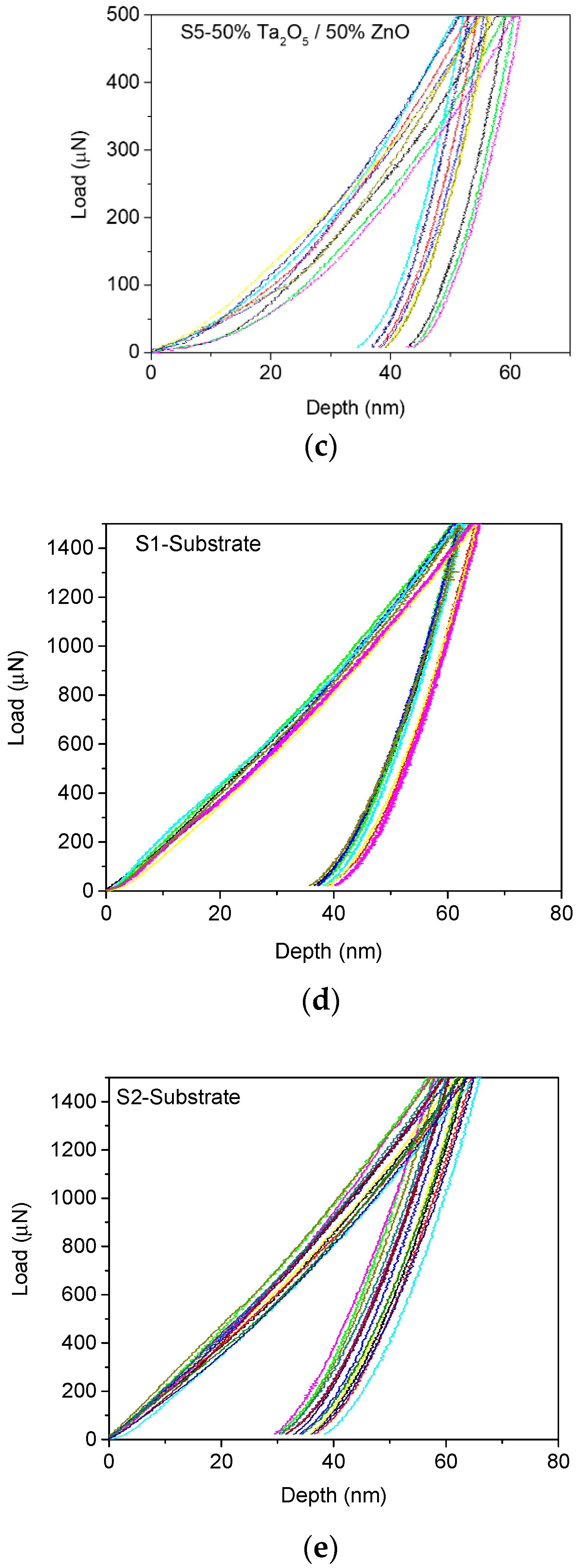
| Sample | Scanned Area (µm2) | 2D Image View of the Layer | 3D Image View of the Layer | Roughness Parameters | |
|---|---|---|---|---|---|
| Ra (nm) | Rrms (nm) | ||||
| S1_layer | 5 |  | 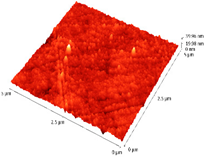 | 1.97 | 2.66 |
| 10 | 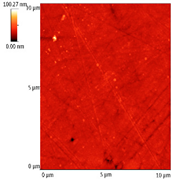 | 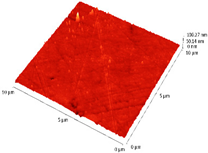 | 2.19 | 3.23 | |
| S3_layer | 5 |  | 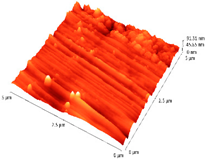 | 6.11 | 8.24 |
| 10 |  |  | 8.90 | 12.80 | |
| S5_layer | 5 | 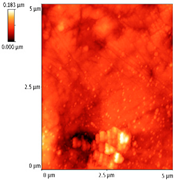 | 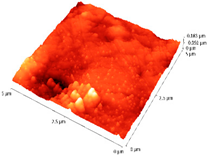 | 14.80 | 20.70 |
| 10 | 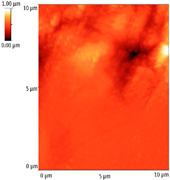 | 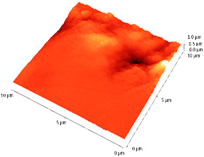 | 54.00 | 88.50 | |
| Sample Zone Layer Force | Average Contact Depth (nm) | SD of Contact Depth (nm) | Average Hardness (GPa) | SD of Hardness (GPa) | Average Reduced Modulus (GPa) | SD of Reduced Modulus (GPa) |
|---|---|---|---|---|---|---|
| S1_substrate_0v5mN | 37.365 | 0.849 | 4.703 | 0.127 | 118.533 | 4.079 |
| S3_substrate_0v5mN | 54.306 | 3.397 | 2.95 | 0.242 | 98.846 | 9.5 |
| S5_substrate_0v5mN | 49.231 | 3.229 | 3.372 | 0.283 | 116.376 | 6.968 |
| S1_substrate_1v5mN | 51.211 | 1.506 | 9.594 | 0.363 | 206.789 | 6.977 |
| S2_substrate_1v5mN | 47.731 | 2.892 | 10.549 | 0.822 | 189.637 | 5.833 |
Publisher’s Note: MDPI stays neutral with regard to jurisdictional claims in published maps and institutional affiliations. |
© 2021 by the authors. Licensee MDPI, Basel, Switzerland. This article is an open access article distributed under the terms and conditions of the Creative Commons Attribution (CC BY) license (https://creativecommons.org/licenses/by/4.0/).
Share and Cite
Băilă, D.-I.; Vițelaru, C.; Trușcă, R.; Constantin, L.R.; Păcurar, A.; Parau, C.A.; Păcurar, R. Thin Films Deposition of Ta2O5 and ZnO by E-Gun Technology on Co-Cr Alloy Manufactured by Direct Metal Laser Sintering. Materials 2021, 14, 3666. https://doi.org/10.3390/ma14133666
Băilă D-I, Vițelaru C, Trușcă R, Constantin LR, Păcurar A, Parau CA, Păcurar R. Thin Films Deposition of Ta2O5 and ZnO by E-Gun Technology on Co-Cr Alloy Manufactured by Direct Metal Laser Sintering. Materials. 2021; 14(13):3666. https://doi.org/10.3390/ma14133666
Chicago/Turabian StyleBăilă, Diana-Irinel, Cătălin Vițelaru, Roxana Trușcă, Lidia Ruxandra Constantin, Ancuța Păcurar, Constantina Anca Parau, and Răzvan Păcurar. 2021. "Thin Films Deposition of Ta2O5 and ZnO by E-Gun Technology on Co-Cr Alloy Manufactured by Direct Metal Laser Sintering" Materials 14, no. 13: 3666. https://doi.org/10.3390/ma14133666
APA StyleBăilă, D.-I., Vițelaru, C., Trușcă, R., Constantin, L. R., Păcurar, A., Parau, C. A., & Păcurar, R. (2021). Thin Films Deposition of Ta2O5 and ZnO by E-Gun Technology on Co-Cr Alloy Manufactured by Direct Metal Laser Sintering. Materials, 14(13), 3666. https://doi.org/10.3390/ma14133666








